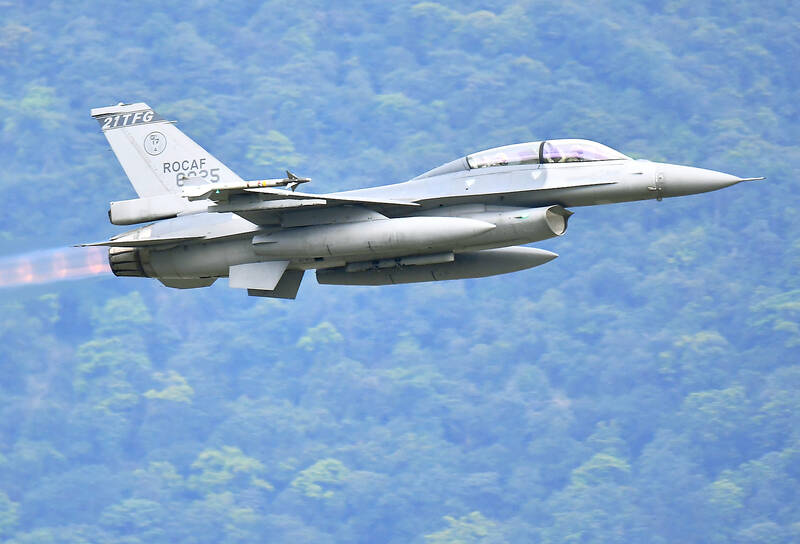The Air Force Command yesterday posted notice of a NT$1.17 billion (US$37.98 million) deal with the US to maintain military aircraft weapon systems training simulators from this year through 2027.
Taiwan’s defense mission to the US inked the restricted tendering contract with the American Institute in Taiwan, the public version of the notice said.
The document did not specify the type of aircraft simulators, but identified the locations as Tainan and Pingtung, where the 1st Tactical Fighter Wing and 6th Mixed Tactical Wing are based respectively.

Photo: You Tai-lang, Taipei Times
The 1st Fighter Tactical Wing operates AIDC F-CK-1 jets and the 6th Mixed Tactical Wing operates Lockheed Martin P-3C Orion maritime patrol aircraft.
However, the maintenance and sustainment package could be related to tactical simulators the air force is due to receive for General Atomics MQ-9B drones and Lockheed Martin F-16Vs, to be delivered by next year and in 2025 respectively.
In other developments, Ocean Affairs Council Minister Kuan Bi-ling (管碧玲) said a Coast Guard Administration project to build frigates domestically for its fleet achieved 50 percent of its goal on Monday.
Kuan gave the update at her first ship delivery ceremony, when the Coast Guard Administration took delivery of its sixth Anping-class offshore frigate, the Jian (吉安, CG607), and its 25th patrol boat (PP-3512) built by Jong Shyn Shipbuilding Co.
The frigate is part of a program launched in 2018 to supply the coast guard with 141 vessels of various tonnages by 2027 at a cost of more than NT$42.6 billion.
Twelve of the frigates were ordered and the delivery of the Jian on Monday meant that half of the order had been completed.
The Jian has self-righting capabilities, and can conduct maritime rescue missions and inspections of fishing boats, as well as drive away suspicious vessels. It is equipped with a rocket system and a remote controlled 20mm cannon.
Alongside the two ships, the event also celebrated the ceremonial launching of the seventh frigate (CG609), which was christened as the Wanli (萬里).
The Anping-class frigates were modeled on the navy’s Tuo Chiang-class corvettes.
As such, both vessels are equipped with a water cannon with a range of 120m, can reach speeds of up to 44 knots (81.5kph) and can withstand up to force 9 winds on the Beaufort scale.
The Jian is to be deployed in eastern Taiwan to protect the nation’s maritime rights and the interests of local fishers, while the Wanli is to join the fleet in the north when it is delivered.
Separately, the Coast Guard Administration yesterday announced that a detachment of its elite Special Task Unit had been deployed to counter Chinese speedboats prowling the waters off of Lienchiang County’s Dongyin Island (東引).
The detachment has familiarized itself with the physical and human geography of the Matsu Islands over the past month in preparation for the mission, which would last at least one week, it said.
The size of the detachment is classified for operational reasons, but one coastal patrol craft has been allocated for the mission, it said.
The unit is the coast guard’s special forces utilized in tactical roles and members don black body armor and helmets on patrol, unlike other coast guard units that wear orange high-visibility uniforms, it added.

An essay competition jointly organized by a local writing society and a publisher affiliated with the Chinese Communist Party (CCP) might have contravened the Act Governing Relations Between the People of the Taiwan Area and the Mainland Area (臺灣地區與大陸地區人民關係條例), the Mainland Affairs Council (MAC) said on Thursday. “In this case, the partner organization is clearly an agency under the CCP’s Fujian Provincial Committee,” MAC Deputy Minister and spokesperson Liang Wen-chieh (梁文傑) said at a news briefing in Taipei. “It also involves bringing Taiwanese students to China with all-expenses-paid arrangements to attend award ceremonies and camps,” Liang said. Those two “characteristics” are typically sufficient

The brilliant blue waters, thick foliage and bucolic atmosphere on this seemingly idyllic archipelago deep in the Pacific Ocean belie the key role it now plays in a titanic geopolitical struggle. Palau is again on the front line as China, and the US and its allies prepare their forces in an intensifying contest for control over the Asia-Pacific region. The democratic nation of just 17,000 people hosts US-controlled airstrips and soon-to-be-completed radar installations that the US military describes as “critical” to monitoring vast swathes of water and airspace. It is also a key piece of the second island chain, a string of

A magnitude 5.9 earthquake that struck about 33km off the coast of Hualien City was the "main shock" in a series of quakes in the area, with aftershocks expected over the next three days, the Central Weather Administration (CWA) said yesterday. Prior to the magnitude 5.9 quake shaking most of Taiwan at 6:53pm yesterday, six other earthquakes stronger than a magnitude of 4, starting with a magnitude 5.5 quake at 6:09pm, occurred in the area. CWA Seismological Center Director Wu Chien-fu (吳健富) confirmed that the quakes were all part of the same series and that the magnitude 5.5 temblor was

The Central Weather Administration has issued a heat alert for southeastern Taiwan, warning of temperatures as high as 36°C today, while alerting some coastal areas of strong winds later in the day. Kaohsiung’s Neimen District (內門) and Pingtung County’s Neipu Township (內埔) are under an orange heat alert, which warns of temperatures as high as 36°C for three consecutive days, the CWA said, citing southwest winds. The heat would also extend to Tainan’s Nansi (楠西) and Yujing (玉井) districts, as well as Pingtung’s Gaoshu (高樹), Yanpu (鹽埔) and Majia (瑪家) townships, it said, forecasting highs of up to 36°C in those areas